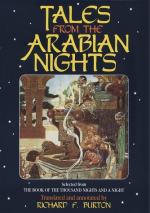[FN#39] This is our corruption of the Malay Aigla = sandal wood. See vol. ix. 150.
[FN#40] Lit. = the Day of Assembly, “Yaum al-Mahshar.” These lines were translated at Cannes on Feb. 22n, 1886, the day before the earthquake which brought desolation upon the Riviera. It was a second curious coincidence. On Thursday, July 10th, 1863—the morning when the great earthquake at Accra laid in ruins the town and the stout old fort built in the days of James ii—I had been reading the Koranic chapter entitled “Earthquakes” (No. Xcix.) to some Moslem friends who had visited my quarters. Upwards of a decade afterwards I described teh accident in “Ocean Highways” (New Series, No. II., Vol. I, pp. 448-461), owned by Trubner & Co., and edited by my friend Clements Markham, and I only regret that this able Magazine has been extinguished by that dullest of Journals, “Porceedings of the R. S. S. and monthly record of Geography.”
[FN#41] Galland has un tremblement pareil a celui qu’Israfyel (Israfil) doit causer le jour du jugement.
[FN#42] The idea is Lady M. W. Montague’s ("The Lady’s Resolve.”)
In
part she is to blame that has been tried:
He
comes too near that comes to be denied.
As an unknown correspondent warns me the sentiment was probably suggested by Sir Thomas Overbury ("A Wife.” St. xxxvi):—
—In
part to blame is she
Which
hath without consent bin only tride:
He
comes too near that comes to be denide.
[FN#43] These highly compromising magical articles are of many kinds. The ballad of The Boy and the Mantle is familiar to all, how in the case of Sir Kay’s lady:—
When she had tane the mantle
With purpose for to wear;
It shrunk up to her shoulder
And left her backside bare.
Percy, Vol. I., i and
Book iii.
Percy derives the ballad from “Le COurt Mantel,” an old French piece and Mr. Evans (Specimens of Welsh Poetry) from an ancient Ms, of Tegan Earfron, one of Arthur’s mistresses, who possessed a mantle which would not fit immodest women. See also in Spenser, Queen Florimel’s Girdle (F.Q. iv. 5,3), and the detective is a horn in the Morte d’Arthur, translated from the French, temp. Edward iv., and first printed in A. D. 1484. The Spectator (No. 579) tells us “There was a Temple upon Mount Etna which was guarded by dogs of so exquisite a smell, that they could discover whether the Persons who came thither were chaste or not;” and that they caused, as might be expected, immense trouble. The test-article becomes in the Tuti-nameh the Tank of Trial at Agra; also a nosegay which remains fresh or withers; in the Katha Sarit Sagara, the red lotus of Shiva; a shirt in Story lxix. Gesta Romanorum; a cup in Ariosto; a rose-garland in “The Wright’s Chaste WIfe,” edited by Mr. Furnival for the Early English Text Society; a magic picture in Bandello, Part I., No. 21; a ring in the Pentamerone, of Basile; and a distaff in “L’Adroite Princesse,” a French imitation of the latter.




